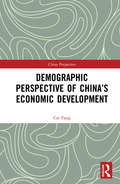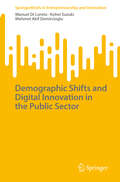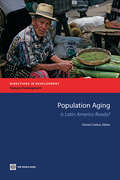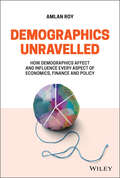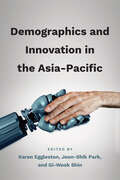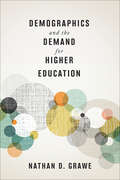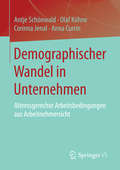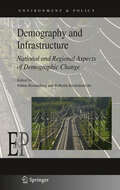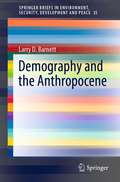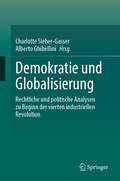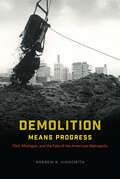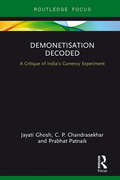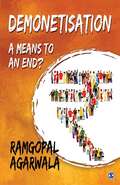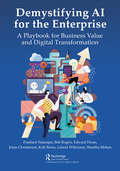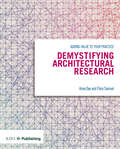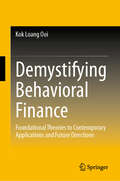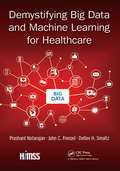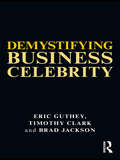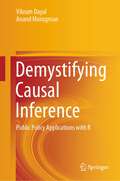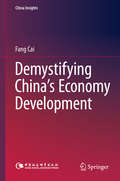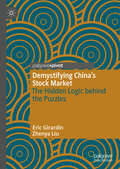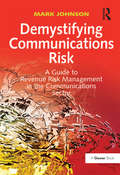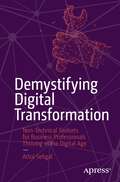- Table View
- List View
Demographic Perspective of China’s Economic Development (China Perspectives)
by Fang CaiChina is historically famous for its high demographic dividend and its huge working population, and this has driven tremendous economic growth over the past few decades. However, that population has begun to shrink and the Lewis turning point whereby surplus rural population has been absorbed into manufacturing is also approaching, leading to great change in the Chinese labor market. Will this negatively affect China’s economic growth? Can the "Middle-Income Trap" be avoided? What reforms should be made on the labor supply side? This book tackles these key questions. This book is a collection of 14 papers presenting the author’s observations, analysis, and opinions of China’s long-term economic development from the demographic perspective, while analysing real economic problems from the past and including policy recommendations. It provides a critical reference for scholars and students interested in Chinese economic development and demographic perspectives on economic development.
Demographic Shifts and Digital Innovation in the Public Sector (SpringerBriefs in Entrepreneurship and Innovation)
by Mehmet Akif Demircioglu Manuel Di Loreto Kohei SuzukiThis book examines the impact of demographic decline on digital innovation in the public sector. Utilizing data from Italian municipalities, it provides quantitative and qualitative analyses to reveal the negative impact of demographic decline on digital innovation, which presents a unique challenge for policymakers seeking to foster technological advances in a shrinking, ageing society. This book also investigates the roles of macro-level social, economic, demographic, and administrative factors in the innovation of public organizations. By highlighting these broader demographic dynamics, this book challenges existing theories of public sector innovation, urging greater attention to slow-moving external factors as critical drivers of long-term innovation strategies.
Demographic Transition and Social Policy in Latin America and the Caribbean
by Daniel CotlearLatin America and the Caribbean will soon face the challenges of an aging population. This process, which took over a century in the rich world, will occur in two or three decades in the developing world; seven of the 25 countries that will age more rapidly are in LAC. Population aging will pose challenges and offer opportunities. This book explores three sets of issues. First is a group of issues related to the support of the aging and poverty in the life cycle. This covers questions of work and retirement, income and wealth, and living arrangements and intergenerational transfers. It also explores the relation between the life cycle and poverty. Second is the question of the health transition. How does the demographic transition impact the health status of the population and the demand for health care? And how advanced is the health transition in LAC? Third is an understanding of the fiscal pressures that are likely to accompany population aging and to disentangle the role of demography from the role of policy in that process. This book provides an introduction to the concepts and techniques at the intersection of demography and economics. It summarizes the policy debate about potential reforms needed to make population aging an opportunity for development.
Demographics Unravelled: How Demographics Affect and Influence Every Aspect of Economics, Finance and Policy
by Amlan RoyDiscover what demographics can tell us about the economy, markets, and the future In Demographics Unravelled, renowned Macro-Demographics expert Amlan Roy delivers an insightful and timely exploration of the impact that “people characteristics” have on national economies. Considering factors like gender, race, migrant status, family background, and education, the author delves deeply into a subject that drives market behavior and economic variables, including growth, debt, inflation, employment, and productivity. These have national and international policy implications. In this one-of-a-kind book, you’ll discover: Why the study of demographics is the hidden key to understanding economic growth, asset prices, and capital flows How to use detailed demographics to forecast future scenarios in economics, socioeconomics, geopolitics, and the environment The short-, medium-, and long-term effects of consumer and worker behavior How understanding demographics is key to understanding health, pensions, migration, sustainability and social policies. It is intimately linked to the Sustainable Development Goals of the UN—Gender, Climate, Poverty and Inequality Perfect for institutional investors, insurance professionals, economists, and business leaders, Demographics Unravelled will also earn a place in the libraries of academics and students studying a variety of economic disciplines and seeking a one-stop and in-depth discussion of demographics-driven macroeconomic effects.
Demographics and Innovation in the Asia-Pacific
by Karen Eggleston, Joon-Shik Park, and Gi-Wook ShinDemographic transition, along with the economic and geopolitical re-emergence of Asia, are two of the largest forces shaping the twenty-first century, but little is known about the implications for innovation. The countries of East Asia have some of the oldest age structures on the planet: between now and 2050, the population that is age 65 and older will increase to more than one in four Chinese, and to more than one in three Japanese and Koreans. Other economies with younger populations, like India, face the challenge of fully harnessing the "demographic dividend" from large cohorts in the working ages. This book delves into how such demographic changes shape the supply of innovation and the demand for specific kinds of innovation in the Asia-Pacific. Social scientists from Asia and the United States offer multidisciplinary perspectives from economics, demography, political science, sociology, and public policy; topics range from the macroeconomic effects of population age structure, to the microeconomics of technology and the labor force, to the broader implications for human well-being. Contributors analyze how demography shapes productivity and the labor supply of older workers, as well as explore the aging population as consumers of technologies and drivers of innovations to meet their own needs, as well as the political economy of spatial development, agglomeration economies, urban-rural contrasts, and differential geographies of aging.
Demographics and the Demand for Higher Education
by Nathan D. GraweThe decisions we make in the next five years are critical in determining whether colleges thrive or flounder.2017 National Student Clearinghouse Research Center Award for Outstanding AACRAO SEM Research PresentationHigher education faces a looming demographic storm. Decades-long patterns in fertility, migration, and immigration persistently nudge the country toward the Hispanic Southwest. As a result, the Northeast and Midwest—traditional higher education strongholds—expect to lose 5 percent of their college-aged populations between now and the mid-2020s. Furthermore, and in response to the Great Recession, child-bearing has plummeted. In 2026, when the front edge of this birth dearth reaches college campuses, the number of college-aged students will drop almost 15 percent in just 5 years.In Demographics and the Demand for Higher Education, Nathan D. Grawe has developed the Higher Education Demand Index (HEDI), which relies on data from the 2002 Education Longitudinal Study (ELS) to estimate the probability of college-going using basic demographic variables. Analyzing demand forecasts by institution type and rank while disaggregating by demographic groups, Grawe provides separate forecasts for two-year colleges, elite institutions, and everything in between. The future demand for college attendance, he argues, depends critically on institution type. While many schools face painful contractions, for example, demand for elite schools is expected to grow by more than 15 percent in future years.Essential for administrators and trustees who are responsible for recruitment, admissions, student support, tenure practices, facilities construction, and strategic planning, this book is a practical guide for navigating coming enrollment challenges.
Demographischer Wandel in Unternehmen
by Antje Schönwald Olaf Kühne Corinna Jenal Anna CurrinDer demographische Wandel verändert nahezu alle Lebensbereiche nachdrücklich. Besonders wirksam wird er in der Arbeitswelt. In der qualitativen wie quantitativen Studie werden Einflüsse auf die Arbeitsfähigkeit älterer Arbeitnehmer in saarländischen Industrieunternehmen aus der Perspektive der Arbeitnehmer selbst untersucht und dabei insbesondere die sogenannten weichen Faktoren wie Arbeitsklima, Zufriedenheit, Wohlbefinden, Partizipation oder Ansprüche an Führungskräfte, berücksichtigt. Damit richtet sich das Buch insbesondere an Personalverantwortliche, Betriebsräte, aber auch an WissenschaftlerInnnen, die sich mit dem demographischen Wandel, insbesondere in der Arbeitswelt, befassen.
Demography and Infrastructure
by Wilhelm Kuckshinrichs Tobias KronenbergPopulation ageing has been going on for many decades, but population shrinking is a rather new phenomenon. The population of Germany, as in many other countries, has passed a plateau and is currently shrinking. Demographic change is a challenge for infrastructure planning due to the longevity of infrastructure capital and the need to match supply and demand in order to ensure cost-efficiency. This book summarises the findings of the INFRADEM project team, a multidisciplinary research group that worked together to estimate the effects of demographic change on infrastructure demand. Economists, engineers and geographers present studies from top-down and bottom-up perspectives, focusing on Germany and two selected regions: Hamburg and Mecklenburg-Western Pomerania. The contributors employed a broad range of methods, including an overlapping-generations model for Germany, regional input-output models, an energy systems model, and a spatial model of the transportation infrastructure.
Demography and the Anthropocene (SpringerBriefs in Environment, Security, Development and Peace #35)
by Larry D. BarnettEnvironmentalists devote little attention at the moment to the size and growth of the human population. To counter this neglect, the monograph (i) includes original graphs showing population size and growth since 1920 in the world as a whole and the United States; (ii) assembles evidence tying the increasing number of people to ecosystem deterioration and its societal consequences; and (iii) analyzes sample-survey data to ascertain whether the current disregard of population pressures by U.S. environmentalists reflects the thinking of Americans generally. However, even if a nation took steps primarily intended to lower childbearing and immigration, the findings of social science research indicate that the steps would not have a substantial, lasting impact. The discussion, which suggests an indirect way by which government may reduce fertility, underlines for environmental scholars the importance of studying their subject in a multidisciplinary, collaborative setting.
Demokratie im postkommunistischen EU-Raum: Erfolge, Defizite, Risiken (Vergleichende Politikwissenschaft)
by Martin Brusis Günter Verheugen Karel VodičkaDas Buch analysiert die Lage der Demokratie in elf postkommunistischen EU-Mitgliedstaaten und in Ostdeutschland. Dreißig Jahre nach den friedlichen Revolutionen in Mittel- und Osteuropa gibt es Erfolge und Chancen, aber auch Fehlentwicklungen und Defizite, die im Kontext von europäischer Integration und Transformationsgeschichte untersucht und eingeordnet werden. Das Buch bietet allgemein interessierten Leser*innen einen strukturierten Überblick sowie vertiefte Kenntnisse zu den einzelnen Staaten und dem Sonderfall Ostdeutschland. Dieses Buch eröffnet interessante Vergleichsperspektiven und eine systematische Wissensbasis zur Demokratiequalität im postkommunistischen Raum. Gleichzeitig werden Motive, Abläufe und politische Ergebnisse der EU-Osterweiterung im Zusammenhang dargestellt und die noch zu lösenden Aufgaben beschrieben.
Demokratie und Globalisierung: Rechtliche und politische Analysen zu Beginn der vierten industriellen Revolution
by Charlotte Sieber-Gasser Alberto GhibelliniDieses Buch bietet eine eingehende rechtliche und politische Analyse der Vereinbarkeit des westfälischen Staatsmodells mit der Globalisierung und der digitalen Revolution. Es untersucht das Konzept der Demokratie in einer globalisierten Welt, erörtert die Legitimität der wirtschaftlichen Integration in den globalen Markt und präsentiert drei Fallstudien (aus Brasilien, Taiwan und Spanien) über die Auswirkungen sozialer Medien auf Wahlen. Darüber hinaus werden neue Perspektiven zu den Auswirkungen der Digitalisierung auf nationale Grenzen und auf die Rolle von Bürgerinnen und Bürgern und Expertinnen und Experten bei der Gestaltung der Globalisierung aufgezeigt. Ein abschließendes Kapitel befasst sich mit der Frage, inwieweit die aus den Analysen der oben genannten Aspekte gewonnenen Erkenntnisse bei den Bemühungen um eine Überwindung der aktuellen globalen Gesundheits- und Wirtschaftskrise berücksichtigt werden müssen.
Demolition Means Progress: Flint, Michigan, and the Fate of the American Metropolis (Historical Studies of Urban America)
by Andrew R. HighsmithIn 1997, after General Motors shuttered a massive complex of factories in the gritty industrial city of Flint, Michigan, signs were placed around the empty facility reading, "Demolition Means Progress," suggesting that the struggling metropolis could not move forward to greatness until the old plants met the wrecking ball. Much more than a trite corporate slogan, the phrase encapsulates the operating ethos of the nation's metropolitan leadership from at least the 1930s to the present. Throughout, the leaders of Flint and other municipalities repeatedly tried to revitalize their communities by demolishing outdated and inefficient structures and institutions and overseeing numerous urban renewal campaigns--many of which yielded only more impoverished and more divided metropolises. After decades of these efforts, the dawn of the twenty-first century found Flint one of the most racially segregated and economically polarized metropolitan areas in the nation. In one of the most comprehensive works yet written on the history of inequality and metropolitan development in modern America, Andrew R. Highsmith uses the case of Flint to explain how the perennial quest for urban renewal--even more than white flight, corporate abandonment, and other forces--contributed to mass suburbanization, racial and economic division, deindustrialization, and political fragmentation. Challenging much of the conventional wisdom about structural inequality and the roots of the nation's "urban crisis," Demolition Means Progress shows in vivid detail how public policies and programs designed to revitalize the Flint area ultimately led to the hardening of social divisions.
Demonetisation Decoded: A Critique of India's Currency Experiment
by Prabhat Patnaik C. P. Chandrasekhar Jayati GhoshOn the night of 8 November 2016, at 8:15 pm, India’s Prime Minister, Narendra Modi, announced in a televised broadcast to the nation that with effect from midnight, currency notes of denominations Rs 500 and Rs 1,000 would no longer be legal tender. In one stroke, this involved the de-recognition of over 86 per cent of the value of Indian currency in circulation with only four hours’ notice. This important book provides a quick and concise explanation of the goals, implications, initial effects and the political economy of this major demonetisation move by the Government of India. It clarifies key concepts and offers astute economic analysis to guide the reader through the various claims, arguments and critiques that have been made; highlights the complexities of the processes that have been unleashed; and examines the likely outcomes in the long term as well as those that are immediately evident. Timely and lucid, this book will interest students and researchers in the fields of economics, finance, management, law, politics and governance as well as policy makers, legislators, civil society activists and the media.
Demonetisation: A means to an End?
by Ramgopal AgarwalaOn 8th November 2016, India was caught unaware and shaken to its very roots, when the majority of the currency in circulation became stripped of its value. People were grappling with an entirely unfamiliar situation - ′demonetisation′. The move unleashed a huge debate on television, in newspapers, and on social media, the likes of which had never been seen. Several months later, we are still questioning: Was this a disastrous blunder or a leap forward? To answer these questions, a renowned economist takes an incisive look at the events that led to demonetisation, the aftermath, and its implications. He sifts through many irrelevant rants, a lot of politically motivated mud-slinging, and asks the most important question: What now, what next?
Demystifying AI for the Enterprise: A Playbook for Business Value and Digital Transformation
by Prashant Natarajan Kirk Borne Leland Wilkinson Bob Rogers Edward Dixon Jonas Christensen Shantha MohanArtificial intelligence (AI) in its various forms –– machine learning, chatbots, robots, agents, etc. –– is increasingly being seen as a core component of enterprise business workflow and information management systems. The current promise and hype around AI are being driven by software vendors, academic research projects, and startups. However, we posit that the greatest promise and potential for AI lies in the enterprise with its applications touching all organizational facets. With increasing business process and workflow maturity, coupled with recent trends in cloud computing, datafication, IoT, cybersecurity, and advanced analytics, there is an understanding that the challenges of tomorrow cannot be solely addressed by today’s people, processes, and products. There is still considerable mystery, hype, and fear about AI in today’s world. A considerable amount of current discourse focuses on a dystopian future that could adversely affect humanity. Such opinions, with understandable fear of the unknown, don’t consider the history of human innovation, the current state of business and technology, or the primarily augmentative nature of tomorrow’s AI. This book demystifies AI for the enterprise. It takes readers from the basics (definitions, state-of-the-art, etc.) to a multi-industry journey, and concludes with expert advice on everything an organization must do to succeed. Along the way, we debunk myths, provide practical pointers, and include best practices with applicable vignettes. AI brings to enterprise the capabilities that promise new ways by which professionals can address both mundane and interesting challenges more efficiently, effectively, and collaboratively (with humans). The opportunity for tomorrow’s enterprise is to augment existing teams and resources with the power of AI in order to gain competitive advantage, discover new business models, establish or optimize new revenues, and achieve better customer and user satisfaction.
Demystifying Architectural Research: Adding Value to Your Practice
by Flora Samuel Anne DyeThis practical, hands on introduction guides you through the basics of undertaking research in day-to-day architectural practice helping you to exploit the growing opportunities on offer. It explores how developing a research specialism can improve the quality of your projects, help to define your brand and generate new channels of revenue with innovative services for clients. The text is divided into four sections focussing on different types of Architecture Research Practice; commercial, cultural, social and technology. Each section includes a series of inspiring case studies written by practitioners themselves on the way in which research benefits their business as well as an essay by an expert which sets these projects in their methodological context. In this way the book highlights the broad spectrum of research being undertaken and the practical implications for the practice and their projects. This is designed for architects and practices who want to develop a clear specialism that adds brand value and will enable them to access new funding streams as well as students of architecture who are getting to grips with architectural research.
Demystifying Behavioral Finance: Foundational Theories to Contemporary Applications and Future Directions
by Kok Loang OoiThis book provides a thorough examination of behavioural finance, charting its development from foundational theories to contemporary applications and future directions. It delves into the psychological underpinnings of investor behaviour, elucidating how cognitive biases and emotional responses shape financial markets. Beginning with the seminal theories such as Prospect Theory by Kahneman and Tversky, the book explores the contributions of pioneering researchers who laid the groundwork for this field. It then transitions to modern behavioural finance theories, presenting significant research findings and their implications for today's financial landscape. Through detailed case studies, the book illustrates the practical application of behavioural finance principles in investment strategies, corporate finance, and personal finance, offering readers valuable real-world insights. Case studies include analyses of market anomalies like the Tulip Mania and the Dot-com Bubble, as well as modern market disruptions such as the 2008 Financial Crisis, the market reactions during the COVID-19 pandemic, and recent events like the GameStop short squeeze and the cryptocurrency market fluctuations. These examples highlight the influence of behavioural factors on market stability and investor behaviour. Additionally, the book investigates emerging trends and technologies, such as AI and machine learning, and their impact on behavioural finance. It also offers a global perspective, comparing behavioural finance across different cultural and market contexts. The concluding section discusses the policy implications of behavioural finance insights and forecasts the field's future trajectory. Aimed at academics, finance professionals, and advanced students, this book is an indispensable resource for those seeking to understand the intricate relationship between psychology and finance, and a significant contribution to the literature on financial behaviour.
Demystifying Big Data and Machine Learning for Healthcare
by Detlev H. Smaltz Prashant Natarajan John C. FrenzelHealthcare transformation requires us to continually look at new and better ways to manage insights – both within and outside the organization today. Increasingly, the ability to glean and operationalize new insights efficiently as a byproduct of an organization’s day-to-day operations is becoming vital to hospitals and health systems ability to survive and prosper. One of the long-standing challenges in healthcare informatics has been the ability to deal with the sheer variety and volume of disparate healthcare data and the increasing need to derive veracity and value out of it. Demystifying Big Data and Machine Learning for Healthcare investigates how healthcare organizations can leverage this tapestry of big data to discover new business value, use cases, and knowledge as well as how big data can be woven into pre-existing business intelligence and analytics efforts. This book focuses on teaching you how to: Develop skills needed to identify and demolish big-data myths Become an expert in separating hype from reality Understand the V’s that matter in healthcare and why Harmonize the 4 C’s across little and big data Choose data fi delity over data quality Learn how to apply the NRF Framework Master applied machine learning for healthcare Conduct a guided tour of learning algorithms Recognize and be prepared for the future of artificial intelligence in healthcare via best practices, feedback loops, and contextually intelligent agents (CIAs) The variety of data in healthcare spans multiple business workflows, formats (structured, un-, and semi-structured), integration at point of care/need, and integration with existing knowledge. In order to deal with these realities, the authors propose new approaches to creating a knowledge-driven learning organization-based on new and existing strategies, methods and technologies. This book will address the long-standing challenges in healthcare informatics and provide pragmatic recommendations on how to deal with them.
Demystifying Business Celebrity
by Timothy Clark Brad Jackson Eric GutheyBusiness celebrities such as Bill Gates, Richard Branson and Rupert Murdoch are among the most widely recognised, admired and sometimes even vilified individuals in the world. Like their celebrity peers from the entertainment, sports, arts and political worlds, business celebrities exert an influence that is pervasive, but difficult to assess, evaluate and explain. Business celebrities have been around for as long as big business itself, but this is the first book to provide a systematic exploration of how they are constructed and why they exist. Business celebrities include entrepreneurs, CEOs, and management gurus. The book argues that these individuals are not self-made, but rather are created by a process of widespread media exposure to the point that their actions, personalities and even private lives function symbolically to represent significant dynamics and tensions prevalent in the contemporary business environment. Demystifying Business Celebrity raises questions about the impact and significance of the production of celebrity upon our understanding of, and our ability to promote the practice of leadership in an enlightened manner. The book will prove a useful addition to the enlightened business student’s bookshelf and will be informative reading for all those with an interest in business and management.
Demystifying Causal Inference: Public Policy Applications with R
by Vikram Dayal Anand MurugesanThis book provides an accessible introduction to causal inference and data analysis with R, specifically for a public policy audience. It aims to demystify these topics by presenting them through practical policy examples from a range of disciplines. It provides a hands-on approach to working with data in R using the popular tidyverse package. High quality R packages for specific causal inference techniques like ggdag, Matching, rdrobust, dosearch etc. are used in the book.The book is in two parts. The first part begins with a detailed narrative about John Snow’s heroic investigations into the cause of cholera. The chapters that follow cover basic elements of R, regression, and an introduction to causality using the potential outcomes framework and causal graphs. The second part covers specific causal inference methods, including experiments, matching, panel data, difference-in-differences, regression discontinuity design, instrumental variables and meta-analysis, with the help of empirical case studies of policy issues. The book adopts a layered approach that makes it accessible and intuitive, using helpful concepts, applications, simulation, and data graphs. Many public policy questions are inherently causal, such as the effect of a policy on a particular outcome. Hence, the book would not only be of interest to students in public policy and executive education, but also to anyone interested in analysing data for application to public policy.
Demystifying China's Economy Development
by Fang CaiThis book explains why China's opening-up policy can boost the rapid growth of its economy. Based on concrete facts and economic logic, it offers a brief introduction to the history of China's successful development, which has unprecedentedly helped improve people's lives and community welfare over the past 30 years. In light of the newly emerging problems, the author assesses the different stages of China's economic development and new challenges, illustrating how the country's sustainable growth could be achieved through further reforms so as to complete the transition from a middle-income to high-income country. He moves on to discuss the lessons learned from China's experiences and summarizes their significance for other developing countries, while also clarifying popular misconceptions such as the "China Menace" and "Theory of China's Collapse. " Taking the logic of economic development as a basis and employing economic norm analysis methods, the book describes China's economic miracle in plain but vivid language and attempts to enrich the economic development theory through China's experience.
Demystifying China’s Stock Market: The Hidden Logic behind the Puzzles
by Zhenya Liu Eric GirardinMainstream research has rationalized China’s stock market on the basis of paradigms such as the institutional approach, the efficient market hypothesis, and corporate valuation principles. The deviations from such paradigms have been analyzed as puzzles of China’s stock market. Girardin and Liu explore to what extent, in the perspective of Chinese cultural and historical characteristics, far from being puzzles, these 'deviations’ are rather the symptoms of a consistent strategy for the design, development and regulation of a government-dominated financial system. This book will help investors, observers and researchers understand the hidden logic of the design and functioning of China’s modern stock market, taking a political economy view.
Demystifying Communications Risk: A Guide to Revenue Risk Management in the Communications Sector
by Mark JohnsonThe rapid pace and increasing convergence of internet, phone and other communications technologies has created extraordinary opportunities for business but the complexity of these new service mixes creates parallel opportunities for fraud and revenue leakage. Companies seeking to use communications technology as a delivery or payment platform for digital services are particularly at risk. They need to understand both their strategic and operational risks as well as those affecting their stakeholders - partners and customers. Effective risk management is as much about awareness, culture, training and organization as it is about technology. Mark Johnson's practical guide, Demystifying Communications Risk, highlights cases from a wide range of geographies and cultures and is designed to raise awareness of the multi-faceted and often complex forms that operational revenue risks take in the communications sector. It provides managers with an understanding of the nature and implications of the risks they face and the human, organizational and technological approaches that can help avoid or mitigate them.
Demystifying Digital Transformation: Non-Technical Toolsets for Business Professionals Thriving in the Digital Age
by Attul SehgalEquip yourself with tools to approach digital transformation within your organization successfully. Today, over 80% of digital transformation engagements fail to reach their objectives (as reported through a survey by Couchbase). The challenge to overcome is that the pace of change in digital has left business users falling behind. Geared towards non-technical professionals, this book seeks to get executives on track to lead this innovation wave.Data as the prime lever in this innovation wave has accelerated the pace of change from earlier innovation waves by 25 years. Companies are finding it hard to adapt as their internal processes do not allow such rapid changes. Companies are stuck with outdated tools to manage DX projects. This leads to outsourcing the responsibility for DX to IT teams and outside system developers and causing great problems. Toolsets from data visualization, simulated prototyping, video editing and Whiteboarding will be introduced and simplified to show you can use simplify them to deliver on your business goals. Case studies that feature the digital transformation journeys of companies like Hertz, BBC, Domino's Pizza and more will be explored. What You'll LearnDerive business outcomes and KPIs to successfully direct digital transformation InitiativesWork with new toolsets that business owners can use to effectively collaborate with data scientists, data analysts and data engineersRecognize valuable data and align data monetization with business goalsWho This Book is ForNon-technical business owners and professionals
Demystifying Economics
by Allen W. SmithDemystifying Economics, Student Edition, is designed for classroom use. In combination with the optional Student Supplement to Accompany Demystifying Economics, it makes an excellent, comprehensive textbook for teaching introductory economics at both the college and high school levels. The book provides a survey of basic economics written in simple language with the use of concrete examples that relate economics to ordinary daily life. The content includes most of the topics covered in an introductory college level economics course, but the material is presented in a very reader-friendly format.
